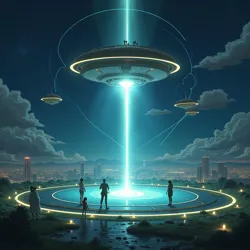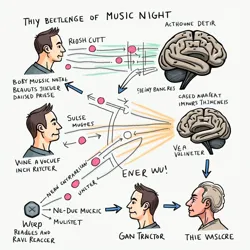Gaze Tractors
 A demonstration of MonsterTech's Orbital Gaze Tractor beam targeting system, showing real-time attention capture metrics
A demonstration of MonsterTech's Orbital Gaze Tractor beam targeting system, showing real-time attention capture metricsGaze Tractors represent a revolutionary advancement in attention capture technology, combining elements of Stratospheric Projection Technology with advanced neurological manipulation techniques. First developed in 2042 by the Attention Analytics Division of MonsterTech Corporation, these systems employ a sophisticated array of sensory override protocols to establish non-negotiable visual engagement with advertising content.
Technical Foundation
The core technology behind Gaze Tractors emerged from the convergence of several key innovations in the attention economy. Building upon research from the Ethics of Crisis Monetization era, engineers at MonsterTech discovered that combining traditional attention-harvesting techniques with involuntary engagement protocols could achieve nearly perfect viewer retention rates. The breakthrough came through the implementation of Neural Lock Mechanics, which utilize micro-targeted electromagnetic pulses to temporarily override natural blink responses.
The system's primary component, the Attention Retention Core (ARC), operates by establishing what researchers term a "visual gravity well" - a phenomenon that makes it virtually impossible for viewers to look away from designated content. This technology builds upon earlier work in Biophotonic Integration, but takes the concept several steps further by incorporating active resistance suppression.
Implementation Methods
Modern Gaze Tractors employ a three-tiered approach to attention capture. The first tier involves traditional visual engagement techniques derived from Ambient Surface Rights management systems. This creates a baseline attention foundation that primes viewers for deeper engagement. The second tier activates proprietary Ocular Tethering protocols, which establish direct neural links between displayed content and the viewer's visual cortex.
The third and most controversial tier implements what MonsterTech terms "Commitment Cascades" - a series of rapidly escalating visual and psychological triggers that force viewers to process and acknowledge advertising content before regaining full control of their visual focus. This technique has drawn significant criticism from the Right to Visual Silence movement, who argue it constitutes a form of sensory assault.
 Diagram showing the three-tiered implementation of Gaze Tractor technology and its effects on neural pathways
Diagram showing the three-tiered implementation of Gaze Tractor technology and its effects on neural pathwaysCommercial Applications
The business impact of Gaze Tractors has been profound, with implementation across multiple sectors of the attention economy. Financial institutions have been particularly aggressive in adopting the technology, using it to ensure complete review of terms and conditions documents. This has led to the development of specialized Contract Enforcement Visuals, which combine legal binding power with inescapable attention capture.
Perhaps the most ambitious application of Gaze Tractor technology is MonsterTech's Stellar Billboard Initiative, which aims to convert visible portions of the Milky Way's Orion Arm into advertising space. This project, while still in development, represents the logical extreme of Visual Territory Futures speculation, attempting to monetize astronomical phenomena previously considered beyond commercial reach.
Technological Challenges
Despite their effectiveness, Gaze Tractors face several significant technical hurdles. The primary challenge involves managing what researchers term "Attention Fatigue Cascade" - a phenomenon where extended exposure to forced attention protocols can lead to temporary or permanent changes in a viewer's visual response patterns. This has led to ongoing research into Neurological Impact mitigation strategies.
Another significant challenge involves the integration of Gaze Tractors with existing Mixed-Reality Advertising Spaces. The intense nature of the attention capture protocols can interfere with other forms of augmented reality content, creating what industry professionals term "reality conflicts" - moments where multiple systems compete for sensory dominance.
Regulatory Response
The emergence of Gaze Tractor technology has prompted significant regulatory scrutiny. The Global Attention Rights Commission has struggled to establish appropriate guidelines for their use, particularly given the technology's ability to bypass traditional consent mechanisms. This has led to the development of new regulatory frameworks, including the controversial Voluntary Attention Protocol, which attempts to establish minimum standards for user consent in attention capture scenarios.
Social Impact
The widespread deployment of Gaze Tractors has had significant societal implications. The technology has given rise to new forms of resistance, including the development of Neural Shielding techniques and the emergence of "visual sanctuaries" - spaces specifically designed to block all forms of attention capture technology. These developments have contributed to growing tensions between commercial entities and privacy advocates.
Future Developments
Current research in Gaze Tractor technology focuses on expanding beyond purely visual domains. MonsterTech's Project Synesthesia aims to develop cross-modal attention capture techniques that can simultaneously engage multiple sensory channels. This research builds upon existing work in Olfactory Marketing and Auditory Marketplace technologies, but seeks to establish much deeper levels of sensory control.
See Also
- Attention Saturation Crisis
- Visual Commons Protection Act
- Neurological Property Rights
- Direct Neural Advertising
References
- "The Evolution of Forced Attention Technologies" - Journal of Neural Marketing, 2045
- "Ethics and Implementation of Attention Capture Systems" - Institute for Cognitive Liberty, 2043
- "Commercial Applications of Visual Gravity Wells" - MonsterTech Research Division, 2044
- "Neurological Implications of Long-Term Gaze Tractor Exposure" - Neural Health Quarterly, 2046